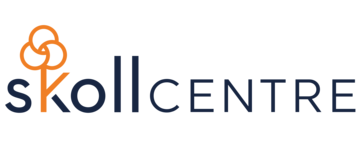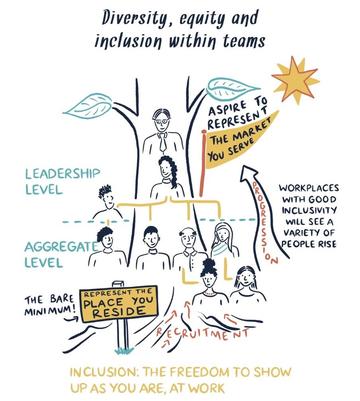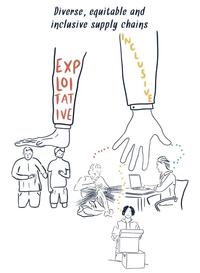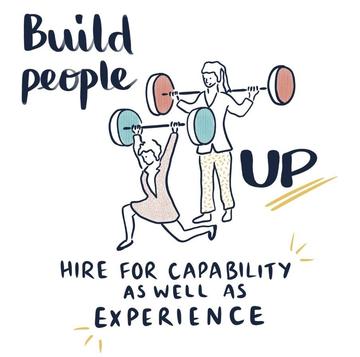
Diversity and equity begin within your company’s team. Without representation internally, it can be extremely challenging to serve diverse consumers and build both culture and operations in ways that don’t reinforce existing paradigms of exclusion or marginalisation.
There are a wide variety of long-standing and emerging practices to help both attract and retain diverse talent in their team. While building a diverse workforce is a strategic advantage, the true upside comes when leadership reflects the diversity of the team that they lead diversity is reflected in leadership. Global research shows that companies with both gender and racial diversity in Management and board level outperform competitors that are not representative. For social enterprises, gender and racial diversity are often critical to designing strategies and programs that are well-attuned with target users and beneficiaries.
While many companies have started improving hiring practices, this does not translate into diverse leadership due to retention, promotion, and internal culture. A positive company culture ensures that everyone has the potential to achieve great things within your company, which then translates to greater representation at all levels.
Introduce Blind Recruitment
Introduce blind recruitment (e.g. anonymising applications, redacting university names) for jobs, in order remove internal bias and encourage more diverse applicants (anecdotally, we have heard it makes a bigger difference to expanding the application pool if you not only use blind recruitment, but also advertise that you are using blind recruitment, so that applicants are aware).
Integrate Diversity from the Outset
In terms of application and recruitment policy setting, Oxford ecosystem members also reported benefits from integrating diversity from the outset, e.g. including people with lived experience of marginalisation to lead policy development
Targets in Recruitment
Equitable and representative outcomes are more likely when processes themselves reflect demographic balance. Applying quotas to the recruitment process can apply to pipeline development and interview rounds, e.g. setting a target to not close applications until a demographically representative sample has applied, even if this requires more outreach or a longer application window. Likewise, in the case of panel interviews, many firms set quotas to ensure their interview or selection panels reflect the demographic split they’d aim to see in the broader workforce.
Apply a Clear Evaluation Process
When representation in pipeline does not translate into representation in applicants or interviewees, put referrals through the same resume screening as traditional applicants , and apply a clear evaluation process such as:
-
Identify a diverse hiring panel of interviewers
-
Do not share resumes with the hiring panel
-
Develop a qualitative rubric for scoring candidates that is agreed upon by all interviewers for each required skill
-
Use skills assessments or evaluations connected to the rubric.
-
Require interviewers to submit scores of candidates before discussing with anyone else in the hiring process.
-
Review the slate of how all candidates scored before making final hiring decision.
Use Data Analytics
Contingent on data availability, it is useful to conduct an annual review of gender and racial diversity by function and level of seniority in order to understand where and why there are gaps in representation. Some factors behind these gaps are covered below. Some companies also conduct analytics to set up short- and long-term EDI goals, measure and track the process, and find improvements to enhance their progress. These strategic approaches are contingent on leadership commitment and the sizes of companies as many small social enterprises are under-resourced to execute.
Assess your Leadership Structure
It is important to consider how company culture, particularly leadership structure, can impact representation and inclusion. Flat, democratic structures can sound great in theory, but there need to be structures and processes in place to ensure this can be translated into practice (e.g. that employees can identify issues and call out problematic behaviour). Likewise, more hierarchical institutions require mechanisms to ensure under-represented voices are echoed in chambers of power. Formal mechanisms (such as shadowing, mentoring, and coaching programmes) can help push under-represented talent up the ladder but there should be incentives or supporting mechanism to reduce the burden of extra work for these underrepresented pioneers. Measures around diversity and inclusion (e.g. employee satisfaction) can be included within performance assessment for leaders for visibility, and linked to incentives.
Improve your Company Culture
Design processes and systems that integrate consideration of barriers faced by team members of diverse backgrounds. This can look like
-
Flexible working plans that accommodate more customised hours and offsite/onsite preferences
-
Support for childcare and other caring responsibilities
-
Exceeding government minimums for maternity, paternity, and shared parental leave policies, including instituting and encouraging equitable shared parental leave policies
Provide clear Promotion Criteria
It is important to have clear promotion criteria based on tasks or outcomes, which reduces likelihood of bias in promotion decisions
In consultation with the local Oxford social entrepreneurship ecosystem, entrepreneurs, systempreneurs, academic researchers, and investors shared the following practices which are improving diversity and inclusion in their organisations. Improved diversity refers to the increase in represented of underrepresented groups in job applicants and employees. Improved inclusiveness refers to the increase in retention rate, and job satisfaction.
Candidate Outreach
-
Promote your job opportunities in an array of channels such as Debut, Brixton Finishing School to ensure visibility across under-represented groups. Limiting to personal networks or platforms that are not gender or racially diverse (which in some cases may include university or sector channels) creates blind spots and skews the talent pool.
-
Diversify targeting settings for digital job ads by using a diverse and inclusive group of keywords and preferences that can reach different pools of talents. For examples, apart from demographic targeting, specific key words around broader interests can be used to reach a wider range of applicants.
-
Leave job ads open longer to ensure a more diverse pool of applicants is achieved before shortlisting.
Job posts, Descriptions, and Interviews
-
Remove jargon from your advert: Wording can inadvertently limit diversity in applicant pools, especially at entry-level. Removing jargon and including language that refers to a company’s equality commitment can ensure a wider uptake in applications from underrepresented groups.
-
Remove gendered language: this should include obvious gender markers, as well as more subtle gendered language (e.g. masculine language around e.g. ‘execution’
-
Emphasise capability over experience: Data have shown that while male applicants will apply for roles where they meet 60% of the required experience, women applicants will often only apply if they meet 100% of the required experience. Ensure the framing in job descriptions accounts for this by emphasising capabilities.
-
Remove proxy job requirements: Consider if the requirements are true measurements of job performance (for example: university degrees).
These resources can help you assess whether your hiring and retention practices are building diversity and equity in your company, as well as outline analysis and strategies to build an inclusive culture.
The Surprising Solution to Workplace Diversity
What does workplace diversity look like in practice? It’s easy for diversity to become a buzzword with very superficial metrics. Yet getting diversity and inclusion right is important for your company and its future. The value of having a diverse workforce has been proven, in relation to profit, productivity, and other measures of success. But how can you go from talking about diversity to making it happen within your company? Arwa Mahdawi, brand strategist and author of the Strong Female Lead, offers top starter tips for recruiting and building diverse teams, including blind interview processes, challenging homogenous workplace cultures, and embracing diversity as the new normal.
The Surprising Solution to Workplace Diversity | Arwa Mahdawi | TEDxHamburg – YouTube
CGIAR: Gender, Diversity and Inclusion Toolkit for People and Culture Practitioners
CGIAR is a global research partnership working towards a food secure future with reduced poverty and enhanced food and nutrition security. Their Gender, Diversity and Inclusion Toolkit offers a journey map of their recruitment process from the candidates’ perspective. This toolkit provides advice on how to map your candidate experience and provides sample resources that help you understand your candidates’ needs, wants, and ambitions on their recruitment journey- designed by a social enterprise.
PowerShift: Mitigating Bias in Recruitment and Hiring Toolkit
The Avarna Group is a women and BIPOC led consultancy that provides resources on diversity, equity, inclusion, and justice (collectively, DEIJ) for the environmental sector. But their resources apply to enterprises within a range of sectors and industries. Avarna’s Recruitment and Hiring Toolkit can help you adapt and enhance the transparency of hiring and recruitment processes within your company. The toolkit offers a set of clear, realistic steps for addressing unconscious bias within your recruitment processes. It includes a checklist for your job description and tips for enhancing the transparency around your hiring timeline and recruitment processes.
Power Shift: A toolkit to mitigate bias in recruitment and hiring
Oxford-based Equitable and Inclusive Recruitment Agencies
Some social enterprises have reported low pipeline as a major barrier. In Oxfordshire, there are equitable and inclusive recruitment agencies, including Beam and Hire2Inspire, for a range of roles.
Gender-decoder Tool for Job Announcements
Tools such as Textio and OnGig gender decoder tools help to remove gendered language from job announcements, that may inadvertently limit a gender-diverse applicant tool

